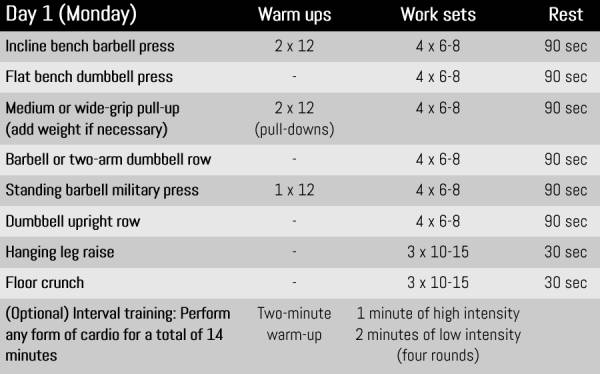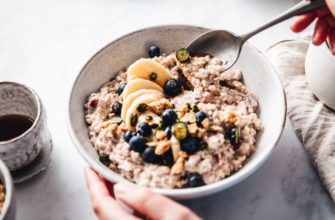Building a powerful, sculpted physique is a feat that demands dedication, discipline, and a well-crafted training regimen. In the pursuit of attaining optimal muscle mass and size, it is indispensable to design a workout plan that maximizes your gains and propels you towards your fitness goals.
Picture yourself transforming into a force to be reckoned with, as you redefine your body composition and unlock unprecedented levels of strength. This article unveils an exceptional workout blueprint that will revolutionize your fitness journey, helping you push your boundaries and shatter plateaus.
Ignite your muscles: The cornerstone of a transformative workout plan lies in the strategic selection of exercises that engage a diverse range of muscle groups. By incorporating compound movements such as squats, deadlifts, bench presses, and pull-ups, you activate multiple muscle fibers simultaneously, forcing them to grow and strengthen.
Challenge your limits: While it is crucial to remain consistent in your training, it is equally vital to challenge your body continuously. Introduce progressive overload by gradually increasing the amount of weight you lift or by altering the intensity, volume, and frequency of your workouts. This constant progression will stimulate muscle growth, ensuring that your gains remain relentless and steady.
- The Ultimate Workout Program for Weight Gain
- Building Muscle and Enhancing Size
- Understanding Weight Gain
- Developing a Workout Routine
- Nutrition and Supplementation Strategies
- Determining Your Weight Gain Goals
- Setting Realistic Expectations
- Establishing a Caloric Surplus
- Monitoring Progress and Making Adjustments
- Questions and answers
The Ultimate Workout Program for Weight Gain
In this section, we will delve into a comprehensive training regimen designed exclusively to aid you in your journey towards achieving significant weight gain. By incorporating a finely crafted series of targeted exercises, you can expect to witness noticeable muscle growth and an increase in overall size. The carefully curated workout plan provided below will guide you through each exercise, ensuring maximum impact and results.
| Exercise | Repetitions | Sets | Rest |
|---|---|---|---|
| Squats | 10-12 | 3-4 | 90 seconds |
| Bench Press | 8-10 | 3-4 | 2 minutes |
| Deadlifts | 6-8 | 3-4 | 3 minutes |
| Shoulder Press | 10-12 | 3-4 | 90 seconds |
| Bent-Over Rows | 8-10 | 3-4 | 2 minutes |
| Barbell Curls | 10-12 | 3-4 | 90 seconds |
| Tricep Dips | 8-10 | 3-4 | 2 minutes |
| Calf Raises | 12-15 | 3-4 | 90 seconds |
To maximize the effectiveness of this workout plan, it is crucial that you maintain proper form and technique throughout each exercise. Additionally, gradually increase the weight and intensity as your strength and endurance improve. Remember to include rest days to allow your muscles to recover and grow.
This tailored weight gain workout program will challenge and stimulate your muscles, promoting muscle hypertrophy and ultimately helping you achieve your desired size and strength. Dedication and consistency in following this plan will unleash your body’s true potential and lead you to the gains you’ve been striving for. Get ready to transform yourself and become the best version of you!
Building Muscle and Enhancing Size

In this section, we will explore effective strategies to promote muscle growth and increase overall size. We will delve into various techniques and practices that can assist individuals in developing their ideal physique.
One fundamental aspect of building muscle and increasing size is implementing a structured workout routine. By incorporating a variety of exercises that target different muscle groups, individuals can stimulate growth in specific areas of their body. It is crucial to focus on compound exercises that engage multiple muscles simultaneously, such as squats, deadlifts, and bench presses, as they provide a solid foundation for overall muscle development.
In addition to a well-thought-out workout routine, proper nutrition plays a vital role in muscle building. Consuming a balanced diet that includes an adequate amount of protein, carbohydrates, and healthy fats is essential. Protein is particularly crucial, as it provides the building blocks necessary for muscle repair and growth. Incorporating lean sources of protein, such as chicken, fish, and tofu, into each meal can optimize muscle-building potential.
Another significant factor in building muscle and enhancing size is ensuring adequate rest and recovery. Allowing the body sufficient time to repair and rebuild muscles is crucial for optimal growth. Adequate sleep, typically around 7-9 hours per night, is essential for muscle recovery. Additionally, incorporating rest days into a workout routine allows the body to replenish glycogen stores and prevent overtraining, ultimately promoting better muscle growth and size.
Supplementation can also be utilized to support muscle growth. Supplements such as creatine monohydrate can help increase strength and muscle volume by enhancing the body’s ability to produce energy during high-intensity workouts. However, it’s essential to consult with a healthcare professional or registered dietitian before incorporating any supplements into a fitness regimen.
Consistency and patience are key when it comes to building muscle and increasing size. It takes time for the body to adapt and grow, so it’s crucial to remain committed to a workout routine and nutrition plan. By consistently implementing the strategies outlined in this section, individuals can maximize their muscle-building potential and achieve their desired size and physique.
| Key Points |
|---|
| Implement a structured workout routine that includes compound exercises |
| Consume a balanced diet with sufficient protein, carbohydrates, and healthy fats |
| Ensure adequate rest and recovery for optimal muscle growth |
| Consider supplementing with creatine monohydrate under professional guidance |
| Maintain consistency and patience in your muscle-building journey |
Understanding Weight Gain
When it comes to achieving your desired physique, gaining weight plays a crucial role in building muscle and increasing size. Understanding the process of weight gain allows you to make informed decisions on your journey towards your fitness goals. This section aims to provide a comprehensive overview of the mechanisms behind weight gain, exploring the factors involved and the importance of a balanced approach.
Weight gain occurs when the body stores excess calories consumed through food and beverages. It is not solely dependent on how much you eat, but also on the quality of the calories consumed and the efficiency of your body in utilizing them. Proper nutrition is the cornerstone of weight gain, as it provides the necessary building blocks for muscle growth and repair.
The two main components of weight gain are muscle mass and fat accumulation. While the ultimate goal is to increase muscle mass, it’s essential to understand that some fat gain is unavoidable in the process. However, a strategic approach to weight gain can minimize excessive fat accumulation, ensuring a healthy balance between muscle and fat.
One key aspect of weight gain is understanding the concept of a calorie surplus. To gain weight, you need to consume more calories than your body requires for maintenance. This surplus provides the additional energy needed for muscle building and growth. However, it’s important to strike a balance and avoid excessive calorie intake, which can lead to unhealthy weight gain and potential health issues.
| Factors Influencing Weight Gain: | The Importance of Balance: |
|---|---|
| Genetics | Proper nutrition |
| Metabolism | Calorie surplus |
| Physical activity level | Optimal macronutrient ratios |
| Hormonal factors | Monitoring progress |
Factors such as genetics, metabolism, physical activity level, and hormonal factors can influence weight gain. Understanding these factors allows you to tailor your approach to meet your individual needs and maximize results.
Ultimately, understanding weight gain involves finding a balance between calorie intake, nutrient quality, exercise routine, and monitoring progress. It’s essential to approach weight gain with a well-rounded mindset, focusing on sustainable practices that promote long-term muscle growth and minimize excessive fat accumulation.
Developing a Workout Routine
In this section, we will explore the process of creating an effective exercise plan to help you achieve your goals of increasing your muscle mass and overall size. Crafting a well-designed workout routine is crucial for maximizing your progress and optimizing your efforts towards building a stronger, more muscular physique.
First and foremost, it is important to establish clear objectives for your workout routine. Define the specific results you want to achieve, whether it be increasing muscle mass, improving strength, or enhancing overall size. Clearly outlining your goals will help guide the rest of your workout planning process.
Next, it’s essential to consider the frequency and duration of your workouts. Determine how many days per week you can commit to training, and allocate sufficient time for each session. This will ensure you have enough time to target different muscle groups adequately and provide the necessary rest and recovery periods for optimal growth.
When developing your workout routine, it’s important to incorporate a variety of exercises that target different muscle groups. This will help promote balanced muscle development and prevent muscle imbalances or overuse injuries. Additionally, varying your exercises can help keep your workouts engaging and prevent plateauing.
Another critical factor to consider is progressive overload, which involves gradually increasing the intensity or difficulty of your exercises over time. By progressively challenging your muscles, you stimulate growth and adaptation, allowing them to become stronger and larger. Incorporating techniques like increasing resistance, adding repetitions, or reducing rest periods can help facilitate progressive overload.
Additionally, it is crucial to prioritize proper form and technique during your workouts. Using correct form not only maximizes the effectiveness of each exercise but also helps prevent injuries. If you are unsure about the proper execution of a particular exercise, consider seeking guidance from a fitness professional or referring to reliable sources for instructional videos or tutorials.
Lastly, it’s essential to listen to your body and be flexible with your workout routine. Adjustments may be needed along the way to accommodate for changes in your fitness level, schedule, or overall well-being. Remember to rest and recover adequately to allow your muscles to heal and grow. Finding the right balance between pushing yourself and allowing for recovery is crucial for long-term success.
In conclusion, developing a well-rounded workout routine involves setting clear goals, establishing a suitable frequency and duration for your sessions, incorporating a variety of exercises, implementing progressive overload, prioritizing proper form, and being adaptable to changes. By following these principles, you can create a workout routine that maximizes your muscle development and size gains.
Nutrition and Supplementation Strategies
In this section, we will explore the various strategies and practices related to nutrition and supplementation that can aid individuals in achieving their goals of muscle growth and increased size. These strategies involve carefully selecting the right foods and supplements to support muscular development and provide the necessary nutrients for optimal performance.
A key component of successful muscle gain is maintaining a well-balanced diet that is rich in protein, carbohydrates, and essential fats. Protein is crucial for muscle repair and growth, while carbohydrates provide the energy needed for intense workouts. Essential fats aid in hormone production and overall body function. By carefully planning and monitoring your macronutrient intake, you can ensure that your body has the necessary fuel and building blocks for muscle growth and recovery.
In addition to macronutrients, it is important to pay attention to micronutrients and vitamins that support muscle development. Foods such as fruits, vegetables, and whole grains are excellent sources of vitamins, minerals, and antioxidants that contribute to overall health and optimize muscle growth. Incorporating a wide variety of these nutrient-dense foods into your diet will provide your body with the necessary micronutrients to support muscle development and overall well-being.
| Key Nutrition Strategies | Key Supplementation Strategies |
|---|---|
| Ensure adequate protein intake from sources such as lean meats, eggs, dairy, and plant-based protein sources. | Incorporate protein supplements like whey protein isolate or casein protein to support muscle recovery and growth. |
| Consume complex carbohydrates like whole grains, brown rice, and sweet potatoes to fuel intense workouts and replenish glycogen stores. | Consider using carbohydrates supplements like dextrose or maltodextrin for quick energy during workouts. |
| Incorporate healthy fats from sources like avocados, nuts, and olive oil to support hormone production and overall body function. | Add omega-3 fatty acid supplements such as fish oil or flaxseed oil for their anti-inflammatory properties and potential muscle-building benefits. |
| Stay hydrated by consuming an adequate amount of water throughout the day to support muscle function and overall health. | Consider using pre-workout and post-workout supplements that contain ingredients like creatine, beta-alanine, and branched-chain amino acids to enhance performance and recovery. |
It is important to note that while nutrition and supplementation strategies can be beneficial, they should be used in conjunction with a well-designed workout plan and proper rest and recovery. Additionally, consulting with a healthcare professional or registered dietitian can provide personalized guidance and ensure that your nutrition and supplementation strategies are aligned with your health and fitness goals.
Determining Your Weight Gain Goals
Understanding and setting your weight gain objectives is a crucial step on your journey to achieving a desired physique. By establishing clear goals, you can create a focused and effective workout and nutrition plan tailored to your individual needs and preferences.
Defining Your Desired Body Composition:
One of the first steps in determining your weight gain goals is defining the body composition you aim to achieve. This involves considering the ideal balance between muscle mass, body fat percentage, and overall size. By clearly identifying your desired body composition, you can tailor your workout plan to prioritize specific muscle groups and focus on the right exercises and training methods.
Setting Achievable Targets:
It is essential to set realistic and attainable weight gain targets. Aiming for gradual and consistent progress is key to avoiding disappointment or burnout. Consider factors such as your current body weight, genetics, and metabolic rate when determining how much muscle and size you can reasonably expect to gain over a specific timeframe.
Establishing a Timeframe:
Having a timeframe in mind can provide structure and motivation to your weight gain journey. However, it is important to strike a balance between setting a realistic timeframe and allowing yourself enough time to make sustainable progress. Remember, building muscle and gaining size is a gradual process that requires dedication and patience.
Accounting for Lifestyle Factors:
Consider your lifestyle factors when setting weight gain goals. Take into account factors such as your work schedule, availability for workouts, and dietary requirements. Adjust your goals accordingly to ensure they align with your lifestyle and allow for consistent adherence to your workout and nutrition plan.
Monitoring and Adjusting:
Regularly monitor your progress towards your weight gain goals and make necessary adjustments along the way. By tracking your muscle gain and body composition changes, you can evaluate the effectiveness of your workout plan and make modifications if needed. Remember to stay flexible and adaptable in your approach, as everyone’s body responds differently to various training methods.
In summary, determining your weight gain goals involves defining your desired body composition, setting achievable targets, establishing a realistic timeframe, accounting for lifestyle factors, and regularly monitoring and adjusting your progress. With a well-defined set of weight gain objectives, you can embark on a purposeful journey towards maximizing your muscle and size potential.
Setting Realistic Expectations
Establishing attainable goals is an essential aspect of any fitness journey. Before embarking on a weight gain workout plan, it is crucial to understand the importance of setting realistic expectations. This section aims to provide guidance on managing your expectations effectively.
Understanding the need for realistic expectations:
It is natural to want immediate results when starting a fitness regimen, but it is important to remember that building muscle and gaining size takes time. Setting realistic expectations allows you to approach your weight gain journey with a well-balanced mindset, avoiding disappointments and unnecessary pressure.
Defining attainable milestones:
Instead of focusing solely on the end result, it is beneficial to set smaller, achievable milestones along the way. These milestones can be based on various factors such as strength improvement, body measurements, or personal accomplishments. By breaking down your weight gain goals into smaller, manageable steps, you can maintain motivation and track progress effectively.
Examining individual factors:
Every individual’s body is unique, and factors such as genetics, metabolism, and overall health can influence the rate at which muscle is gained and size is increased. Recognizing and acknowledging these individual factors can help set realistic expectations that are tailored to your specific circumstances.
Embracing the journey:
Weight gain and muscle building are ongoing processes that require consistent effort and dedication. Rather than viewing it as a destination, it is important to embrace the journey itself. Celebrate each milestone achieved, focus on personal growth, and enjoy the overall experience of becoming stronger and healthier.
Seeking professional guidance:
If you are unsure about how to set realistic expectations or need assistance in designing an effective weight gain workout plan, seeking guidance from a fitness professional or personal trainer can be immensely helpful. Their expertise and knowledge will provide valuable insights into setting realistic goals and creating a customized plan that maximizes your potential.
Conclusion:
Setting realistic expectations is a crucial aspect of any weight gain workout plan. By understanding the need for attainable milestones, considering individual factors, and embracing the journey, you can approach your fitness goals with a balanced and optimistic mindset. Remember, progress takes time, and with proper guidance, dedication, and consistent effort, you can achieve your desired muscle and size gains.
Establishing a Caloric Surplus

Creating an excess in caloric intake is an essential component of a successful weight gain journey. By consuming more calories than your body burns on a daily basis, you can provide your muscles with the fuel they need to grow and increase in size. This section will delve into the importance of establishing a caloric surplus and provide practical tips on how to achieve it.
Without a caloric surplus, your body lacks the necessary energy to support muscle growth. Simply working out and lifting weights is not enough to increase muscle mass – you must also fuel your body with the right amount of calories. This surplus serves as a foundation for achieving the ultimate goal of maximizing muscle and size.
Establishing a caloric surplus involves calculating your daily energy expenditure, which encompasses your basal metabolic rate (BMR) and the calories burned through physical activity. From here, you can determine the appropriate increase in caloric intake needed to create a surplus. Keep in mind that the exact number of surplus calories required varies depending on factors such as your weight, height, age, and activity level.
Choosing the right types of food is also crucial when establishing a caloric surplus. While it may be tempting to consume empty calories from unhealthy sources, it is important to prioritize nutrient-dense options. Foods high in protein, such as lean meats, poultry, fish, eggs, and legumes, are essential for muscle recovery and growth. Additionally, incorporating complex carbohydrates from sources like whole grains, fruits, and vegetables will provide sustained energy for intense workouts.
Consistency is key when it comes to maintaining a caloric surplus. It is important to track your calorie intake and adjust accordingly, ensuring that you consistently consume more calories than you burn. However, it is equally vital to avoid excessive overeating, as this can lead to unwanted fat gain rather than lean muscle mass. Strive for a controlled and sustainable surplus that supports muscle growth without compromising overall health.
In conclusion, establishing a caloric surplus forms the foundation for maximizing muscle and size during a weight gain journey. By calculating your daily energy expenditure and consuming nutrient-dense foods in a controlled manner, you can provide your body with the necessary fuel for muscle growth. Stay consistent and remember that patience and persistence are key as you work towards your goal of achieving optimal muscle mass.
Monitoring Progress and Making Adjustments
Tracking your progress and making necessary adjustments are essential aspects of an effective weight gain workout routine. By closely monitoring your achievements and making timely modifications, you can optimize your muscle and size gains.
Monitoring Progress:
Evaluating your progress allows you to gauge the effectiveness of your workout plan and identify areas that require improvement. Keeping a record of your weights lifted, sets and reps performed, and body measurements can provide valuable insights into your progression over time.
Measuring Strength and Endurance:
Regularly assessing your strength and endurance levels is crucial for tracking muscle development. Use one-rep maximum (1RM) tests to determine the maximum weight you can lift for a specific exercise, and record the results to compare with future tests. Additionally, assess your endurance by monitoring the number of reps you can perform with a given weight before experiencing fatigue.
Monitoring Body Composition:
Body composition measurements can help you understand the changes in muscle mass and body fat percentage. Utilize methods such as skinfold calipers, bioelectrical impedance analysis (BIA), or DEXA scans to track your body composition changes regularly. This information will assist you in determining whether you are gaining lean muscle or if adjustments are needed to your nutrition and training plan.
Tracking Nutritional Intake:
Effective weight gain requires a carefully planned diet. Keeping a food diary or using mobile apps can help you track your daily calorie intake, macronutrient distribution, and meal frequency. By monitoring your nutrition, you can ensure that you are consuming enough calories and macronutrients necessary for muscle growth and recovery.
Making Adjustments:
Based on the data recorded and analyzed, you can make informed adjustments to your weight gain workout plan. If progress seems stagnant or unsatisfactory, consider increasing the intensity, changing exercises, or adjusting your nutrition. Consulting with a fitness professional or personal trainer can provide valuable guidance in making the necessary modifications.
Consistently monitoring your progress and making appropriate adjustments will help you optimize your muscle and size gains, making your weight gain workout plan more effective in achieving the desired results.
Questions and answers
What is the ultimate weight gain workout plan?
The ultimate weight gain workout plan is a comprehensive program designed to help individuals maximize muscle and size through targeted exercises and specific nutrition strategies.
How does the weight gain workout plan differ from a regular exercise routine?
The weight gain workout plan differs from a regular exercise routine by focusing on exercises that promote muscle growth and size, as well as incorporating a specific nutrition plan that supports weight gain.
What are some key exercises included in the weight gain workout plan?
Some key exercises included in the weight gain workout plan may include compound exercises like squats, deadlifts, bench presses, and shoulder presses, as well as isolation exercises targeting specific muscle groups.
How long does it take to see results with the weight gain workout plan?
The time it takes to see results with the weight gain workout plan can vary depending on individual factors such as genetics, diet, and consistency in following the program. However, with dedication and adherence to the plan, noticeable results can usually be seen within a few weeks to a couple of months.
What type of diet is recommended to maximize muscle and size with the weight gain workout plan?
A diet rich in protein, complex carbohydrates, and healthy fats is recommended to maximize muscle and size with the weight gain workout plan. This includes consuming enough calories to support weight gain and muscle growth, as well as prioritizing nutrient-dense foods.
How do I gain weight and build muscle?
To gain weight and build muscle, you need to create a caloric surplus by consuming more calories than you burn. Focus on a balanced diet with a higher intake of protein, carbohydrates, and healthy fats. Incorporate strength training exercises into your workout routine and gradually increase the intensity as your muscles adapt.
What are the best exercises for maximizing muscle and size?
Compound exercises such as squats, deadlifts, bench presses, and pull-ups are highly effective for maximizing muscle and size. These exercises engage multiple muscle groups simultaneously, promoting overall strength and mass gain. Incorporating isolation exercises targeting specific muscle groups can also help to sculpt and define your physique.
Do I need any supplements to gain weight and build muscle?
While supplements can be beneficial, they are not a prerequisite for weight gain and muscle building. A well-balanced diet that provides adequate macronutrients and micronutrients is the foundation for achieving your goals. However, certain supplements like protein powder, creatine, and branched-chain amino acids can enhance muscle recovery and growth when used in conjunction with proper nutrition and training.
How many times a week should I work out to maximize muscle and size?
To maximize muscle and size, it is recommended to strength train at least three to four times a week. This allows for adequate rest and recovery between workouts. It is important to remember that muscle growth occurs during the recovery phase, so overtraining can hinder your progress. Quality and intensity of workouts are more important than quantity.
Can I still do cardio exercises while trying to gain weight and build muscle?
Yes, you can incorporate cardio exercises into your workout routine while trying to gain weight and build muscle. However, it is important to balance cardio with your weightlifting regimen to avoid excessive calorie expenditure. Limit the duration and frequency of cardio sessions, opting for low-impact activities like walking or cycling, which can help improve cardiovascular health without hampering muscle growth.









